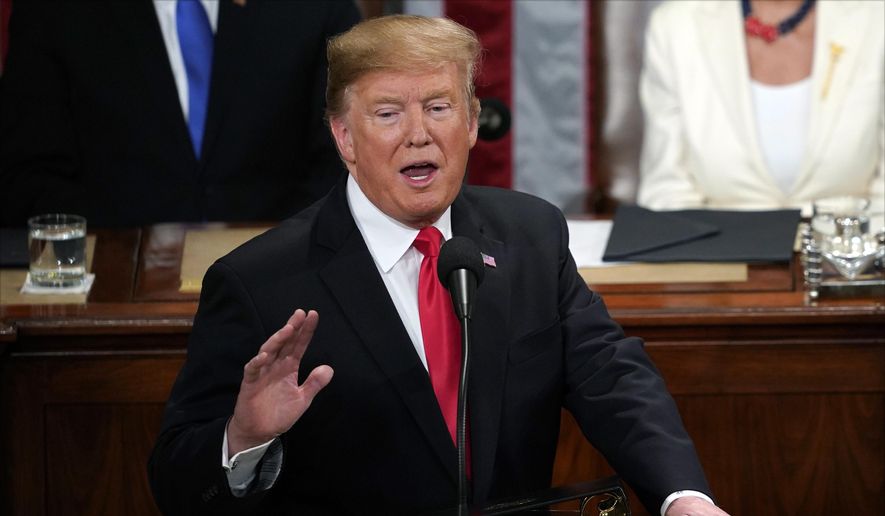President Trump got a rare gift from his State of the Union speech: a significant bump in public approval. Now his challenge is to make it last.
Top pollster Gallup shows Mr. Trump garnered a 7-percentage-point jump, to 44 percent, after his Feb. 5 speech. Rasmussen, Mr. Trump’s preferred pollster, showed him over the magic 50 percent mark, topping out at 52 percent.
“Explain that. How do you get that when you don’t get good press?” Mr. Trump marveled to supporters at a campaign rally last week in El Paso, Texas.
But riding the wave could prove difficult amid a fight over border wall money, a looming report from special counsel Robert Mueller and lousy poll numbers among female voters.
“An ill-advised tweet could do it, or a misstep on a major policy matter,” said Ron Faucheux, a nonpartisan political analyst and publisher of Lunchtime Politics, an online newsletter that tracks polling.
The administration says Mr. Trump has assembled a long list of tangible wins and is winning the public relations game by touting those accomplishments directly to the American people.
Anytime the president can deliver his message without the filter of the media or other D.C. intermediaries, the “result is really good,” one White House official said.
“I think that’s what you saw out of the State of the Union,” the official said.
With some exceptions, recent presidents have seen little gain — or have taken hits — from their January speeches to Congress. Any boost usually receded within a week or two unless the president found something new to sustain his ratings, Mr. Faucheux said.
President Bill Clinton was one such exception. He used his 1995 speech to bridge liberals and conservatives in Congress after his fellow Democrats took a shellacking in the midterm elections.
“He followed through on that strategy, which led to his re-election,” Mr. Faucheux said.
Mr. Trump is at a similar crossroads after his party took a midterm battering along with blame for the longest federal shutdown in history.
The 45th president called for bipartisan unity in his prime-time address, but he faces a series of investigations into his administration and personal business and is navigating ill feelings over his pursuit of a border wall.
Congress reached a deal to keep the government open, but Mr. Trump made lawmakers nervous by declaring a national emergency to build his southern border wall.
Mr. Trump is trying to cut through the negativity by focusing on the strong economy, particularly its ability to lift women.
He cheered economic wins for female workers during his State of the Union address, and he is backing initiatives crafted by daughter Ivanka Trump to assist women abroad.
Still, 6 in 10 women who described themselves as independents strongly disapproved of Mr. Trump in a late-January ABC News/Washington Post poll. White women without college degrees — a vital bloc for Mr. Trump in 2016 — were more likely to strongly disapprove of the president than approve.
“More and more, they’re voting against Trump — suburban white women who are appalled by what they’re seeing out of this White House,” said Jim Manley, a Democratic strategist who served as spokesman for former Senate Minority Leader Harry Reid. “The fact is his polling numbers have been in a pretty narrow range, neither going up much or going down much. I don’t expect that to change anytime soon.”
The White House insists Mr. Trump’s message is reaching women and has made “record successes” among voters of all kinds.
Mr. Trump’s position is certainly looking better than before he took the House rostrum on Feb. 5. His approval rating dropped to 37 percent during the shutdown from late December to late January, nearing his all-time low of 35 percent from late 2017, according to Gallup.
Mr. Trump was especially hurt among independents during the shutdown, but he “has basically recovered among that group,” said Jeff Jones, senior editor for the Gallup Poll. “The State of the Union also gave Trump a platform to remind voters of the good economy, which I think was also a factor in the bumps for [Barack] Obama in 2016 and Trump last year.”
H.W. Brands, a history professor at the University of Texas, said the rostrum in the House chamber for the State of the Union address, watched by millions, is one of the grandest stages.
“I think the bump results from the fact that the State of the Union address makes the president look more presidential than at any other time, with the possible exception of his inaugural address,” Mr. Brands said.
Mr. Faucheux said Mr. Trump’s approval jumped from 42 percent to 46 percent, according to his Lunchtime Politics average.
“That’s a little better than most such speeches,” he said.
Mr. Trump’s first State of the Union address, in 2018, gave him a 2-percentage-point bump. President Barack Obama got a 3-percentage-point bounce in 2015 and a 4-percentage-point boost after his final State of the Union address.
Yet ratings dropped on average for Presidents Jimmy Carter, Ronald Reagan and George W. Bush after their State of the Union addresses.
Mr. Clinton is the big outlier — he was able to spin his speeches into ratings gold in critical years.
His approval rating spiked by 10 percentage points in 1998 — just days after news of his affair with White House intern Monica Lewinsky broke.
⦁ Dave Boyer contributed to this report.
• Tom Howell Jr. can be reached at thowell@washingtontimes.com.




Please read our comment policy before commenting.